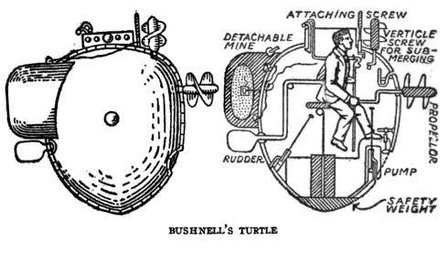On the Way to Inventing the Submarine: Difficult early days
Humans first sailed Earth's seas thousands of years ago, But voyaging beneath the surface was a unique adventure full of problems that needed time to solve.
The first submarine to merit the name was the French all-electric “Gymnote”. The first and most important obstacle before its advent in 1888 was the way submarines defied the human need to be in the open air to breathe it.
Supplying Submersibles with Air
An early solution was attempted when the English mathematician William Bourne designed his “submersible boat” in 1578. Bourne’s craft incorporated a hollow mast which enable air to penetrate the boat from above the surface.
This, of course, limited the depth to which it could submerge, a poser that was solved too late for Bourne and then only in theory: the “submersible catamaran” of 1653 devised by a Frenchman, de Son, was a 72 foot long leather-covered vessel made of wood into which a three-hour supply of air could be pumped.
Taking down supplies of compressed air was also a feature of David Bushnell’s “Turtle” of 1787. This resembled two tortoiseshells joined together. and could provide enough air for thirty minutes. The “Turtle’s” ventilation pipes were safeguarded by self-sealing valves that prevented water swamping the interior.
The Problem of Propulsion
Another, equally taxing stumbling block was the problem of propulsion. In 1620, Cornelius van Drebbel, a Dutchman, proposed his solution - oar power. Unfortunately, it was impractical. Van Drebbel was relying on the same power to submerge his submarine and that was something which could not alter the displacement and so prevented the craft from sinking.
Other inventors had no better luck with achieving propulsion. De Son provided his submersible catamaran with an internal clockwork paddle-wheel, but that proved far too weak to move it,. Bushnell was also foiled, though his attempt could still be classed as a brave try.
A Submarine in the American Revolution
Bushnell fitted his “Turtle” with cranks that operated horizontal and vertical propellers, a method demonstrated in action during the American War of Independence. In September 1776, Sergeant Ezra Lee managed to crank “Turtle” close to the Royal Navy vessel “Eagle” while the ship was an anchor a few miles from New York harbor.
Behind him, Lee towed a 150lb. explosive charge, but was prevented from laying it by the copper sheathing in the “Eagle’s” hull. The sheathing saved “Eagle” from being sunk or crippled for, subsequently, while being chased by a guard boat, Sergeant Lee jettisoned the explosive.
He had already set the clockwork fuse, and the charge blew up in the water with considerable force.
Fourteen years later, it was the turn of the American inventor Robert Fulton to tackle the propulsion problem. Fulton’s “Nautilus” of 1800 featured hand-operated screw propulsion and a hollow spike for laying explosive charges onto the bottom of enemy ships.
Three Important Innovations
Fulton, too, was frustrated for his ingenuity and that of other inventors could not prevail until three major innovations arrived on the scene.
One was the accumulator battery and another, independent motor power. The third, the Whitehead fish-type torpedo,was not perfected for several decades, until 1868. Another twenty years passed before all three were simultaneously available.
Only then did submarines become a practical proposition in battle , and one that could make a meaningful contribution to warfare at sea.
Even so, the efforts of earlier inventors were not wasted. In fact, between them, they explored or demonstrated many indispensible principles of submarine operation.
Contributions by Early Inventors
Even though Bourne’s submersible of 1578 was never built, its design included provision for variable displacement without which no submarine could submerge. Bushnell’s “Turtle” was able to ballast down, as was the hopefully named “Plongeur Marin” or Sea Diver constructed by the Bavarian inventor Wilhelm Bauer in 1850 and Bauer’s later submarine “Le Diable Marin” (Devil Diver) of 1856.
Bauer showed, too, how trapped submariners could escape from their craft when in 1851, the sheet iron plating on the tank-shaped “Plongeur Marin” buckled in under pressure and deposited Bauer and his two-man crew on the bed of Kiel harbor.
Death seemed certain until Bauer persuaded his petrified companions to let in enough water to equalize pressure inside the submarine.This maneuver burst open the hatches and the three men were catapulted to the surface and safety.
Exploits of the “H.L. Hunley”
Fulton’s “Nautlius”, which could submerge to a depth of 25 ft., featured a round conning tower with glass scuttles, and so showed how submerged craft could acquire eyes. Much later, during the American Civil War of 1861-1865, the “H.L. Hunley”, a “David” submersible of the Confederate navy demonstrated that a submarine could “kill” a surface vessel.
The Union sloop “Housatonic” succumbed to the “Hunley’s” spar torpedo in the first such sinking on February 17, 1864. This set the scene for the emergence of the French “Gymnote” a quarter century later and with that, the advent of modern submarine warfare.
Sources:
Ragan, Mark K.: Submarine Warfare in the Civil War (Cambridge, Massachusetts:Da Capo Press), ISBN-10: 0306811979/ISBN-13: 978-0306811975
Parker, John: The World Encyclopedia of Submarines: An Illustrated Reference to Underwater Vessels of the World Through History, from the Nautilus and Hunley to Modern Nuclear-powered Submarines (Jackson, Tennessee: Lorenz Books, ISBN-10: 0754817075/ ISBN-13: 978-0754817079
https://shellbuckling.com/presentations/nonCylinders/pages/page_59.html
http://battleships-cruisers.co.uk/submarines2.htm
